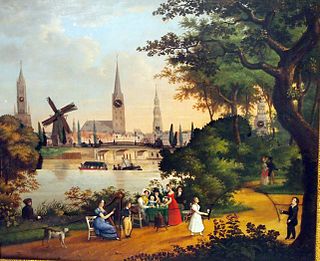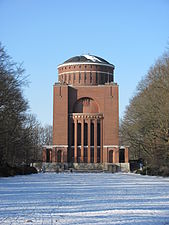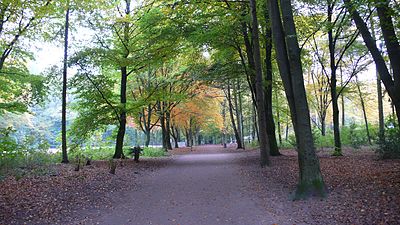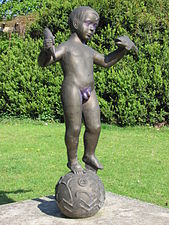
Hamburg, officially the Free and Hanseatic City of Hamburg, is the second-largest city in Germany after Berlin, as well as the overall 7th largest city and largest non-capital city in the European Union with a population of over 1.85 million. Hamburg's urban area has a population of around 2.5 million and is part of the Hamburg Metropolitan Region, which has a population of over 5.1 million people in total. The city lies on the River Elbe and two of its tributaries, the River Alster and the River Bille. One of Germany's 16 federated states, Hamburg is surrounded by Schleswig-Holstein to the north and Lower Saxony to the south.

The Alster is a right tributary of the Elbe river in Northern Germany. It has its source near Henstedt-Ulzburg, Schleswig-Holstein, flows somewhat southwards through much of the Free and Hanseatic City of Hamburg and joins the Elbe in central Hamburg.

Außenalster or Outer Alster Lake is the larger one of two artificial lakes, which are formed by the Alster River and are both located within the city limits of Hamburg, Germany. The other „lake“ is the Binnenalster. The Außenalster and its shores are used by the inhabitants of Hamburg for many sport and recreational purposes, such as sailing and rowing.

The Hamburger Kunsthalle is the art museum of the Free and Hanseatic City of Hamburg, Germany. It is one of the largest art museums in the country. The museum consists of three connected buildings, dating from 1869, 1921 (Kuppelsaal) and 1997, located in the Altstadt district between the Hauptbahnhof and the two Alster lakes.

Hamburg-Nord is one of the seven boroughs of the Free and Hanseatic City of Hamburg, in northern Germany. In 2020, according to the residents registration office, the population was 315,514 in an area of 57.5 km2.

Poppenbüttel is a quarter in the borough Wandsbek of Hamburg, Germany. In 2020 the population was 24,135.

Jungfernstieg is an underground railway station in the city centre of Hamburg, Germany, served by the underground railway (U-Bahn) and the suburban railway (S-Bahn). The station is one of Hamburg's busiest rapid transit hubs.

Rotherbaum is a quarter of Eimsbüttel, a borough of Hamburg, Germany. In 2020 the population was 17,114.
This article covers Sport in Hamburg, Germany — its history and role as part of the city's culture, both on a recreational and professional level. Over the last some 125 years, many international tournaments and championships were held here.

EppendorfGerman pronunciation (help·info) is one of thirteen quarters in the Hamburg-Nord borough of Hamburg, Germany, and lies north of the Außenalster. In 2020 the population was 24,806.

The Jungfernstieg is an urban promenade in Hamburg, Germany. It is the city's foremost boulevard.

Altona Volkspark is a 205-hectare (507-acre) large urban park in the Hamburg district of Bahrenfeld, in the borough of Altona. Ahead of Hamburg Stadtpark, it is the largest park in Hamburg. Altona Volkspark is located some 3 km off the inner city. The largest parks in the city-center are Planten un Blomen and Alsterpark.

Alte Wöhr is a station on the Hamburg-Altona link line and served by the trains of Hamburg S-Bahn lines S1 and S11. The station is also known as Alte Wöhr (Stadtpark), due to its proximity to Hamburg Stadtpark. It was opened in 1931 and is located in the Hamburg district of Barmbek-Nord, Germany. Barmbek-Nord is part of the borough of Hamburg-Nord.

Neustadt is one of the inner-city districts of the Free and Hanseatic City of Hamburg, Germany.

Hamburg Planetarium is one of the world's oldest, and one of Europe's most visited planetariums. It is located in the district of Winterhude, Hamburg, Germany, and housed in a former water tower at the center of Hamburg Stadtpark.

The Wallring is a semi-circular urban ensemble encircling the inner city of Hamburg. It consists of a four-lane ring road with a total length of 3.3 kilometers (2.1 mi) and a continuous built-up street front on its inner side. The outer perimeter is – for the largest part – made up by a string of parks.

Barmbek-Süd (help·info) is a quarter of Hamburg, Germany, in the borough of Hamburg-Nord. It is located in the east of Hamburg-Nord, approximately five kilometers from Hamburg city center. Barmbek-Süd is a densely built-up area.

The Picture clock with Alster panorama, also known as the Coffeeparty on the Alster with view over Lombard Bridge to the city, is a picture clock or music box painting (Spieluhr-Gemälde) – an oil painting of a landscape scene with integrated mechanical clock, automata and music box – that is in the collection of the Museum for Hamburg History. 74 cm x 89 cm in size, it was made between 1827 and 1830 by an unknown group of artists and craftsmen. It was restored in 2012 by the museum and watchmaker Helmut Tüxen.































